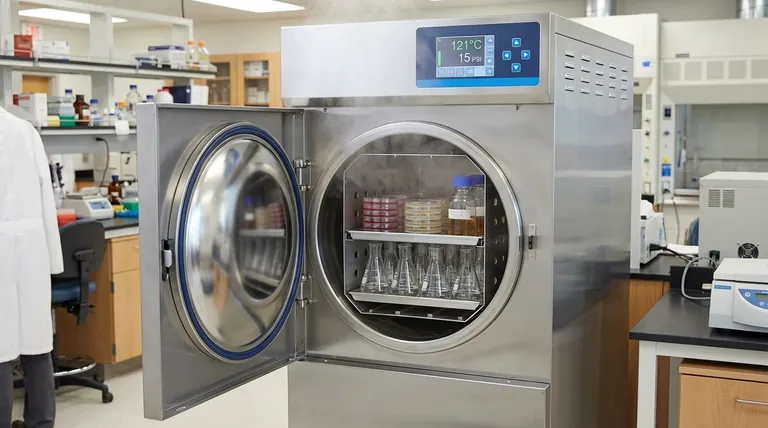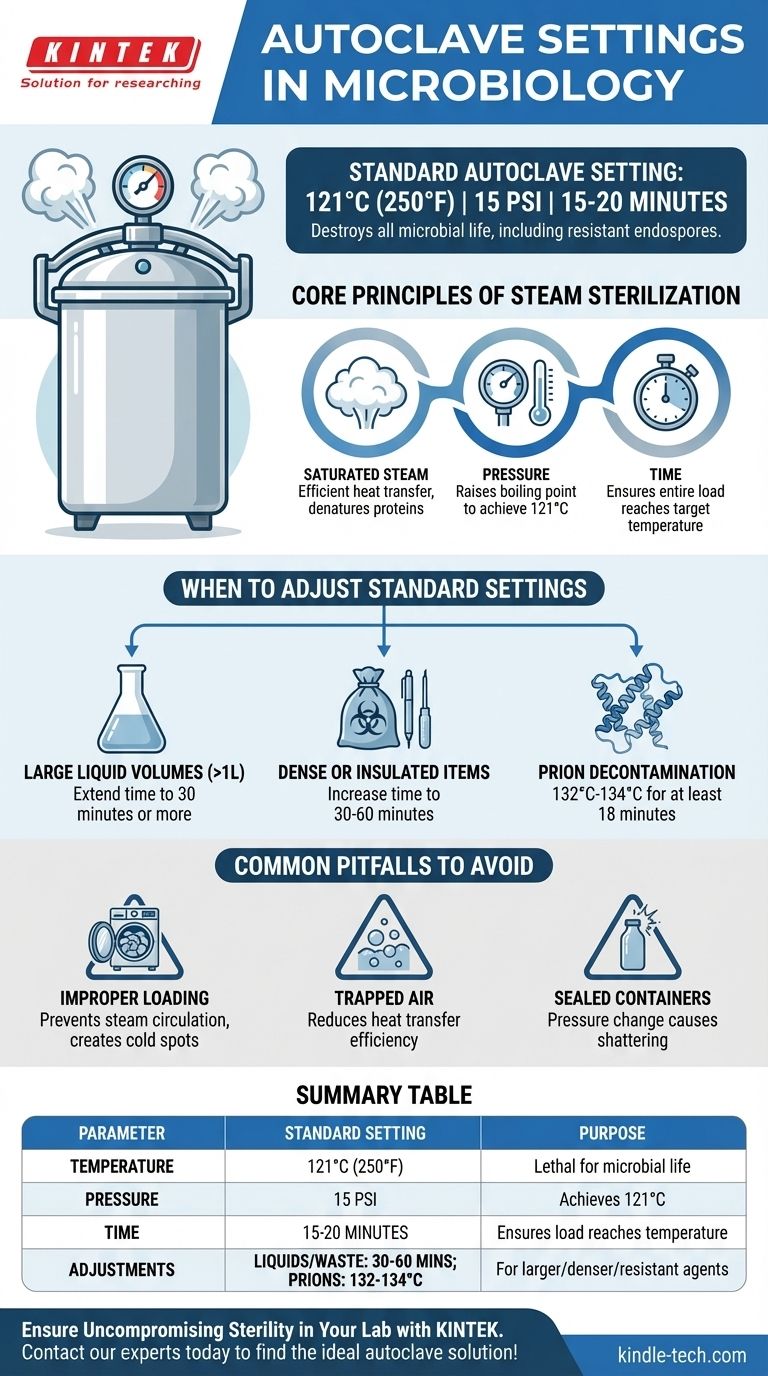In microbiology, the standard autoclave setting is a temperature of 121°C (250°F), under a pressure of 15 pounds per square inch (psi), for a minimum of 15 to 20 minutes. These specific parameters are designed to ensure the complete destruction of all microbial life, including the highly resistant endospores produced by some bacteria.
The effectiveness of an autoclave isn't just about high heat; it's about the synergistic power of temperature, high-pressure saturated steam, and sufficient time. This combination ensures that steam penetrates every surface of the load, denaturing essential proteins and enzymes to achieve true sterility.

The Core Principles of Steam Sterilization
Understanding why these specific settings are the standard is crucial for ensuring your sterilization process is both effective and reliable. The three core components work together to eliminate microorganisms.
The Role of Saturated Steam
Steam under pressure is the actual sterilizing agent. Saturated steam is a far more efficient carrier of thermal energy than dry air, allowing it to rapidly transfer heat to microorganisms, coagulating and denaturing their essential proteins.
The Importance of Pressure
The pressure inside the autoclave serves one primary purpose: to raise the boiling point of water. At normal atmospheric pressure, water boils at 100°C. By increasing the pressure to 15 psi above atmospheric pressure, the autoclave can achieve a steam temperature of 121°C, which is lethal to resilient bacterial spores.
The Critical Factor of Time
The 15-20 minute duration is not arbitrary. This timeframe ensures that the entire load—from the surfaces of glassware to the center of a liquid medium—reaches and maintains the target temperature of 121°C long enough to kill all present microorganisms.
When to Adjust Standard Settings
While 121°C for 15-20 minutes is the gold standard, the total cycle time often needs adjustment based on the nature of the load. The timer should only start after the chamber reaches the target temperature and pressure.
For Large Liquid Volumes
A 2-liter flask of culture media will take significantly longer to reach 121°C at its core than a 100-milliliter bottle. For larger volumes, the sterilization time is often extended to 30 minutes or more to ensure the entire liquid mass is properly heated.
For Dense or Insulated Items
Decontaminating biohazard bags filled with waste or sterilizing a large bundle of surgical instruments requires longer exposure. Steam needs more time to penetrate these dense loads, so cycle times may be increased to 30-60 minutes.
For Prion Decontamination
Prions, the infectious proteins responsible for diseases like Creutzfeldt-Jakob, are exceptionally resistant to standard autoclaving. Deactivating them requires more extreme conditions, typically 132°C-134°C for at least 18 minutes, often in combination with chemical treatments.
Common Pitfalls to Avoid
Achieving sterility requires more than just setting the correct numbers. The process can easily fail if the autoclave is not used properly.
Improper Loading
Overpacking the autoclave chamber is a common mistake. Tightly packed items prevent steam from circulating freely, creating cold spots where microorganisms can survive. Always leave space between items.
Trapped Air
Air is the enemy of steam sterilization. If air is not fully purged from the chamber, it prevents the formation of pure saturated steam, significantly reducing heat transfer efficiency and leading to sterilization failure at the standard settings.
Sealed Containers
Never autoclave a container with a tightly sealed lid. The extreme pressure change will cause it to shatter. Lids on bottles and flasks must be loosened to allow for pressure equalization.
Making the Right Choice for Your Goal
Your specific goal dictates the precise application of these principles.
- If your primary focus is routine sterilization of media and glassware: The standard 121°C at 15 psi for 15-20 minutes is the correct and most efficient setting.
- If your primary focus is decontaminating biohazardous waste: Increase the cycle time to 30-60 minutes to ensure full steam penetration into the dense material.
- If your primary focus is sterilizing liquid volumes larger than 1 liter: Extend the cycle time to 30 minutes or more and use a slow-exhaust or liquid cycle setting to prevent the media from boiling over.
Mastering these settings and principles transforms the autoclave from a simple machine into a reliable tool for guaranteeing sterility in your laboratory.
Summary Table:
| Parameter | Standard Setting | Purpose |
|---|---|---|
| Temperature | 121°C (250°F) | Lethal temperature for microbial life, including spores. |
| Pressure | 15 psi | Raises the boiling point of water to achieve 121°C. |
| Time | 15-20 minutes | Ensures the entire load reaches and maintains the target temperature. |
| Adjustments | Liquids/Waste: 30-60 mins Prions: 132-134°C |
For larger volumes, dense loads, or highly resistant agents. |
Ensure Uncompromising Sterility in Your Lab with KINTEK
Mastering autoclave settings is critical for reliable results and safety. KINTEK specializes in high-performance lab autoclaves and consumables designed to deliver precise temperature and pressure control for perfect sterilization cycles every time.
Let us help you achieve guaranteed sterility for your media, glassware, and biohazardous waste. Contact our experts today to find the ideal autoclave solution for your microbiology laboratory's specific needs!
Visual Guide

Related Products
- Laboratory Sterilizer Lab Autoclave Herbal Powder Sterilization Machine for Plant
- Laboratory High Pressure Steam Sterilizer Vertical Autoclave for Lab Department
- Desktop Fast Laboratory Autoclave Sterilizer 35L 50L 90L for Lab Use
- Desktop Fast Laboratory Autoclave Sterilizer 20L 24L for Lab Use
- Portable Digital Display Automatic Laboratory Sterilizer Lab Autoclave for Sterilization Pressure
People Also Ask
- What is an autoclave used for in a lab? Achieve Total Sterilization for Lab Safety and Integrity
- Why is autoclave temperature 134? Achieve Rapid Sterilization for Critical Instruments
- What is the function of autoclave in tissue culture laboratory? Ensure Absolute Sterility for Successful Cell Growth
- What is the temperature of autoclave in microbiology lab? Achieve Sterile Conditions with 121°C
- What autoclave is used for sterilization? The Definitive Guide to Steam Sterilization



















